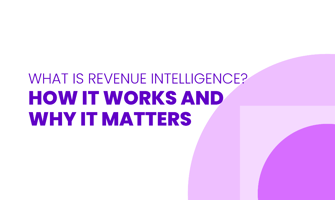Understanding where your revenue comes from and which marketing efforts drive the most success is...
Revenue Attribution 101: Principles and Business Impact
Revenue attribution is the process of understanding which marketing, sales, or customer engagement activities contribute to a company’s revenue. It allows businesses to identify the specific efforts that drive results, enabling smarter decision-making and resource allocation.
In this article, we’ll explore the fundamental principles of revenue attribution and how implementing the right strategies can significantly impact a business’s success.
Want insights on "revenue intelligence"? Read: "What is Revenue Intelligence? How It Works and Why It Matters."
What is Revenue Attribution?
Revenue attribution is a key concept for understanding where your business's income comes from. It’s the process of linking revenue to specific marketing and sales activities, helping you see which efforts are driving results.
By using revenue attribution, you can connect the dots between your marketing strategies and the money your business earns. Every customer interacts with your business in different ways before making a purchase.
These interactions, called touchpoints, might include seeing an ad, reading an email, or talking to a salesperson. Revenue attribution works by identifying which of these touchpoints are most effective at turning interest into income.
For example, it can tell you whether an Instagram ad or a webinar played a bigger role in convincing a customer to buy.
Here’s why this is important: without revenue attribution, you might spend money on marketing strategies that don’t work well while underinvesting in the ones that do. By analyzing how different channels contribute to revenue, you can focus your efforts and your budget on the activities that have the greatest impact.
Revenue attribution also helps you understand how marketing and sales connect. For example, it can show how a particular campaign influenced leads and how those leads turned into paying customers.
This provides a clear measure of how effective your marketing is. Instead of relying on guesses, you get data that shows what’s working and what isn’t.
Companies like 180ops simplify revenue attribution by offering actionable insights and aligning marketing, sales, and customer success efforts to help businesses achieve measurable growth.
In short, revenue attribution gives you clarity. It helps you figure out where your revenue comes from, which activities are worth your investment, and how marketing and sales efforts lead to measurable outcomes. Without it, you’re operating in the dark.
![]()
Principles of Revenue Attribution
1. Single-Touch Attribution
Understanding how to assign credit for generating revenue is important for evaluating the success of your marketing and sales efforts. A single-touch attribution model offers one way to do this, but it comes with both benefits and important limitations.
This model works by assigning all the credit for a sale to just one touchpoint in the customer exploration. A touchpoint could be a specific interaction, like clicking on an ad, signing up for an email list, or making a purchase directly after a demo.
For example, if a customer buys something right after clicking a social media ad, the single-touch model would credit the ad for the entire sale. While this approach is simple and easy to implement, it has significant drawbacks.
By focusing on only one point in the exploration, the model ignores the steps the customer might have taken before or after that touchpoint. For example, a person might first discover your product through a blog post, then attend a webinar, and only later click on an ad to make the purchase.
In this case, single-touch attribution would overlook the blog post and webinar, even though they played a role in the decision to buy.
This oversimplification can also lead to skewed conclusions. It doesn’t reflect the complexity of sales cycles where customers often interact with multiple channels before making a decision.
As a result, you might end up overinvesting in the touchpoint that seems to drive sales, while underestimating the value of the other steps that contribute to conversions.
2. Multi-Touch Attribution
Multi-touch attribution is an important model because it helps you understand how different interactions with your business contribute to revenue.
Instead of giving full credit to just one touchpoint, this model spreads the credit across multiple customer interactions during their buying exploration. This approach better reflects the complexity of how customers move through the sales funnel and interact with your marketing efforts.
There are several common ways to assign credit within the multi-touch attribution model. Each method uses a different strategy to divide the credit among touchpoints:
Linear attribution: This method gives equal credit to every touchpoint in the buyer’s exploration. For example, if a customer interacts with your website, sees an ad, and then talks to a salesperson, all three touchpoints would get the same share of the credit.
Time-decay attribution: In this model, touchpoints closer to the final conversion like a purchase get more credit. Earlier interactions still receive some credit, but their impact is considered smaller.
U-shaped attribution: Here, the first and last touchpoints (such as the initial website visit and the final purchase) are given the most credit, while the middle interactions receive less. This model emphasizes the importance of both starting the relationship and closing the deal.
W-shaped attribution: This method splits credit between three key stages: the first touchpoint, the lead conversion, and the final purchase. It also assigns smaller portions of credit to any other touchpoints in between.
Each of these models helps you analyze customer behavior in different ways. The choice of model depends on your business goals and how you want to value the customer exploration.
3. Data-Driven Attribution
Data-driven attribution is a powerful way to understand how different marketing and sales efforts contribute to your revenue. Instead of guessing which steps in the customer exploration matter most, this model uses advanced analytics to divide credit across multiple touchpoints.
At its core, data-driven attribution relies on machine learning to analyze customer behaviors. Machine learning examines patterns in how people interact with your business like clicking an ad, visiting your website, or speaking with a salesperson.
This approach is more precise than older methods because it looks at actual data from your customers. It doesn't assume that one type of interaction, like a first click or a final purchase, is the most important.
For example, if someone saw an ad, read an email, and then made a purchase, data-driven attribution might show that the email played the biggest role. Or it might find that the ad was just as important as the email. The key is that the model adjusts based on real-world performance, instead of relying on fixed rules.
Businesses benefit from this because it helps them focus their efforts where they’ll make the most impact. When you know which steps in the exploration drive revenue, you can improve your strategies and use your budget more effectively.
180ops specializes in implementing data-driven attribution models, using advanced analytics to provide accurate insights into customer behavior and campaign performance.
![]()
Business Impact of Revenue Attribution
1. Improved ROI Tracking
Understanding how well your marketing efforts pay off is important for smarter decision-making. Revenue attribution helps you measure ROI more accurately by showing which campaigns bring in the most revenue. Without it, you might be guessing where your budget is working best.
Using revenue attribution, you can see which campaigns generate the highest ROI. For example, if one campaign leads to more sales than another, you'll know where to focus your future efforts. This approach removes the guesswork, so you can stop wasting money on strategies that don't work.
You can also compare ROI across different channels, like email, social media, or paid ads. This lets you refine your investment strategy by focusing on the channels that deliver the most value. For example:
If social media ads consistently outperform email marketing, you could allocate more funds to social media.
If a specific email campaign drives more sales, you might double down on similar tactics for future campaigns.
2. Better Budget Allocation
Revenue attribution plays an important role in helping businesses make smarter decisions about how to use their marketing and sales budgets. By analyzing where your revenue comes from, you can focus your resources on strategies and channels that deliver the best results.
One of the biggest advantages of revenue attribution is that it helps you identify high-performing channels. Whether it’s a specific ad campaign, a social media platform, or a sales strategy, attribution data shows you which efforts are driving the most revenue.
This allows you to adjust your budget to prioritize these successful approaches, ensuring you get the most value out of your investment. For example, if a particular email campaign generates a significant number of conversions, you can allocate more funds to similar campaigns in the future.
At the same time, revenue attribution helps you reduce wasted spending. It pinpoints underperforming strategies or channels that don’t contribute much to your bottom line.
Once you know what isn’t working, you can reallocate those resources to areas with greater potential. For example, if a paid advertising campaign on one platform shows poor results, you can shift that budget to a different platform or strategy that has proven more effective.
3. Enhanced Customer Insights
Understanding your customers is one of the most important parts of running a business. Revenue attribution helps you do this by showing how customers interact with your business before making a purchase.
By mapping the customer journey, revenue attribution identifies the key moments, or "touchpoints," that influence purchasing decisions.
For example, you can see if a customer first discovered your product through an online ad, then clicked on an email, and finally made a purchase after visiting your website. This mapping allows you to understand which steps matter most in the decision-making process, so you can focus on what works.
Revenue attribution also helps you break down your customer base into distinct segments. These segments are based on behaviors and preferences, like how often people buy, what they purchase, or how they engage with your marketing.
Once you know who your customers are and what they care about, you can create strategies that speak directly to their needs.
For example, you might find that one group prefers discounts, while another values premium service. Tailoring your approach to each segment helps you connect with customers more effectively.
4. Stronger Collaboration Across Teams
Revenue attribution plays a key role in helping teams work together more effectively. Showing exactly which efforts contribute to revenue, creates a shared understanding between departments like sales and marketing.
This shared perspective reduces misunderstandings and ensures everyone is focused on the same goals. When sales and marketing teams see how their actions impact revenue, they can align their strategies more closely.
For example, marketing can adjust campaigns to target the leads that sales find most valuable, while sales can prioritize follow-ups with prospects that marketing identifies as high-potential.
This back-and-forth coordination becomes easier when both teams rely on the same attribution data to guide their decisions. Sharing attribution insights doesn’t just benefit sales and marketing. It can also help other departments like product development or customer success. For example:
Marketing insights can inform product teams about features that attract customers.
Sales feedback can highlight areas where customers need more support.
Customer success teams can use attribution data to understand which interactions improve retention.
By fostering transparency through shared data, revenue attribution encourages cross-functional collaboration.
When teams work from the same information, they trust each other more and can collaborate without unnecessary friction. This unified approach leads to better strategies and stronger results across the board.
Best Practices for Implementing Revenue Attribution
Set Clear Goals and Objectives
Define what you aim to achieve with revenue attribution.
Focus on key questions like identifying profitable channels or understanding campaign performance.
Align objectives with your broader business strategy to avoid wasting time on irrelevant data.
Choose the Right Attribution Model
Evaluate different models based on your needs:
Single-Touch Attribution: Simple but focuses on only one touchpoint.
Multi-Touch Attribution: Distributes credit across several touchpoints in the customer journey.
Data-Driven Attribution: Uses advanced analytics to assign credit based on real customer behavior.
Consider factors like business goals, customer journey complexity, and data availability.
Ensure Accurate and Comprehensive Data Collection
Collect data from all marketing channels, including ads, emails, social media, and offline activities.
Use tools and platforms that consolidate data across channels.
Regularly audit your data to ensure its accuracy and completeness.
Integrate and Track Across Platforms
Ensure seamless integration of tools and platforms for unified data tracking.
Leverage analytics software to simplify attribution processes and gain actionable insights.
Regularly Review and Adapt
Test your attribution model and adapt it as customer behaviors and business needs evolve.
Continuously monitor performance to ensure alignment with your objectives.
180ops ensures successful implementation of revenue attribution by offering tailored strategies, ensuring data accuracy, and supporting businesses in selecting the best attribution models for their goals
Conclusion
Revenue attribution is more than just assigning credit it’s about uncovering actionable insights that help businesses grow.
By understanding which activities drive revenue, organizations can optimize their marketing and sales strategies, allocate resources effectively, and make data-driven decisions.
Whether through single-touch, multi-touch, or data-driven attribution models, adopting the right approach can empower businesses to maximize their ROI and achieve long-term success.
FAQ
What is revenue attribution?
Revenue attribution is the process of identifying which marketing, sales, or customer interactions contribute to generating revenue for a business. It helps businesses understand the effectiveness of their efforts and optimize strategies accordingly.
Why is revenue attribution important for businesses?
Revenue attribution is important because it:
Shows which efforts are driving revenue.
Improves decision-making with accurate data insights.
Helps allocate budgets to the most effective strategies.
What are the common types of revenue attribution models?
The common types include:
Single-Touch Attribution (First-Touch or Last-Touch).
Multi-Touch Attribution (Linear, U-Shaped, W-Shaped, Time-Decay).
Data-driven attribution, which uses advanced analytics.
How do businesses choose the right attribution model?
Businesses choose an attribution model based on factors like their goals, the complexity of the customer journey, and the availability of data. Testing different models can also help determine the most suitable approach.
What challenges do companies face with revenue attribution?
Some challenges include integrating data across platforms, ensuring data accuracy, and selecting the right attribution model for complex customer journeys. Adapting to changes in customer behavior can also be difficult.




